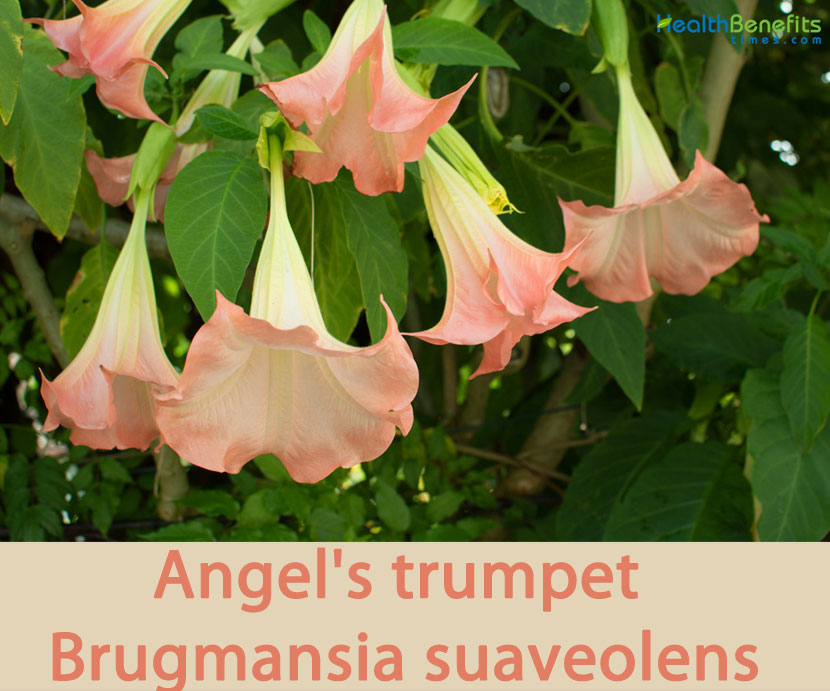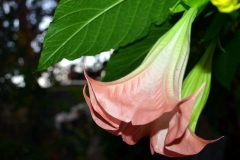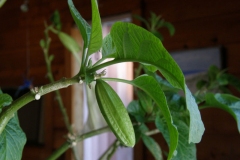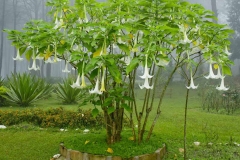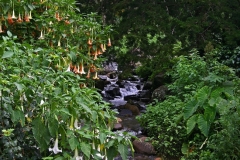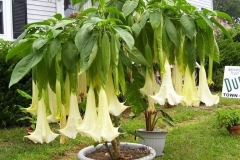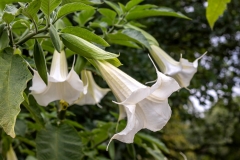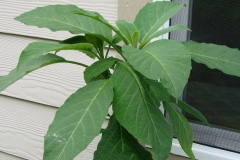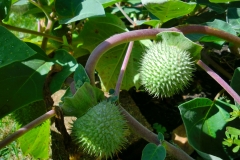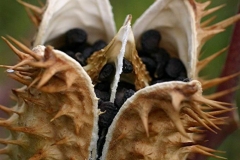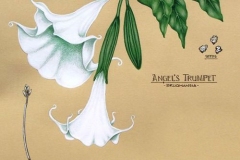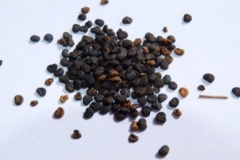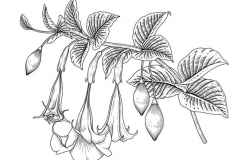The genus name was given in honor of Sebald Justin Brugmans (1763-1819), a Dutch botanist and physician. Latin specific epithet suaveolens means with a sweet fragrance. The common name Angel’s Trumpet comes from the trumpet-shaped flowers being aimed downwards, resembling the angelic horns. The name refers to two different plants – Brugmansia and Datura, and is often used for both genera. In many tropical and temperate areas of the world it is used as an ornamental plant (e.g. Europe) and in traditional medicine. It is also considered an invasive weed, having escaped from cultivation, particularly in the Pacific but occasionally elsewhere. In parts of eastern Australia it blocks waterways by forming extensive colonies through vegetative reproduction. It should also be monitored in other countries where present, especially in Africa and Asia. Like close relatives in the genus Datura, Brugmansia species consists of alkaloids which are used as narcotics and are responsible for cases of accidental poisoning.
Angel’s Trumpets Facts
| Angel's trumpet Quick Facts | |
|---|---|
| Name: | Angel's trumpet |
| Scientific Name: | Brugmansia suaveolens |
| Origin | Coastal rainforests of south eastern Brazil |
| Shapes | Smooth, 4-valved, indehiscent, lanceolate-ellipsoid, fusiform, berry-like capsule |
| Health benefits | Aches and pains, skin irritation, dermatitis, arthritis, infections, headache, rheumatism and different types of inflammations. |
| Name | Angel’s trumpet |
|---|---|
| Scientific Name | Brugmansia suaveolens |
| Native | Coastal rainforests of south eastern Brazil. As a result of human interaction with this species, it can now be found growing in residential areas throughout much of South America; and occasionally in Central America, Mexico, California, Greece and even in parts of Florida |
| Common Names | Angel’s trumpet, night bells, trumpet flower, white angel’s-trumpet, angel star, angel’s tears, Brazil’s white angel trumpet, snowy angel’s trumpet, cornucopia, datura, devil’s trumpet, downy thorn-apple, Hindu datura, Hindu thorn-apple, hoary thorn-apple, horn-of-plenty, jimson weed, metel, purple thorn-apple, thorn apple |
| Name in Other Languages | Brazil: Trombeteira, zabumba branca Dutch: Engelentrompet English: Angel’s-tears, Angel’s-trumpet, White angel’s-trumpet, Trumpet flower Fijian: Mbo ni wai, mbondavui, mbua ni wai, ndavui, uvuuvu Finnish: Kellopasuuna French: Stramoines odorante, stramoine en arbre, trompette des anges, Ganda: Amaduudu German: Wohlriechende Engelstrompete, Duftende Engelstrompete Hebrew: דטורה Hindi: Dhatura (धतूरा) Indonesian: Kecubung hutan Italian: Stramonio del Perù Japanese: Kidachi-chôsen-asagao (キダチチョウセンアサガオ) Malayalam: Eyñcals ṭrampaṟṟ (എയ്ഞ്ചൽസ് ട്രമ്പറ്റ്), Ummata Manipuri: Sagol hidaka (সগোল হিদাক) Mizo: Tawtaw-rawtpar Nepali: Ḍhvām̐gē dhaturō (ढ्वाँगे धतुरो) Norwegian: Engletrompet Peru: Chuchupanda, xupu Portuguese: Trombeteira, belas-noites, cornucópias-de-vénus, saias-de-vénus, trombetas, saia-branca, Quechua: Marikawa Russian: Brugmansiya dushistaya (бругмансия душистая) Spanish: Floripondio, Belas-noites, Boas-noites, Trombetas, Trombeteira, Reina de la noche, angel’s trumpet, floripondio, campana de Paris, floripundia Swedish: Änglatrumpet Tamil: Madulam (மாதுளம்) Uganda: Mududu |
| Plant Growth Habit | Semi-woody shrub or small tree |
| Growing Climates | Found in lowland rainforest, forest edges, disturbed habitats, riverbanks and urban open spaces. It is sometimes naturalized in dense forest along streams |
| Plant Size | 3 m tall, or to 4.5 m or taller under optimal conditions, and usually with a many-branched single trunk |
| Leaf | Alternate, with an entire or coarsely toothed margin, oval, pointed, 10-30 cm long and 5-15 cm wide, becoming even larger when plants are grown in the shade. |
|
Flower |
Flowers are 20-35 cm long and trumpet-shaped, showy and sweetly fragrant, borne singly in the upper leaf forks on stalks 2-3 cm long |
| Fruit Shape & Size | Smooth, 4-valved, indehiscent, lanceolate-ellipsoid, fusiform, berry-like capsule. It is 2.5 to 3.5 inches long with a round to egg-shaped appearance |
| Seed | Numerous, compressed, unevenly shaped, coarsely rugose-tuberculate, 4 x 6 mm |
| Propagation | By tree cuttings or via seeds |
| Plant Parts Used | Leaves, seeds, flower |
| Lifespan | Lasts more than two years |
| Culinary Uses |
|
Plant Description
Angel’s trumpet is a semi-woody shrub or small tree that normally grows about 3 m tall, or to 4.5 m or taller under optimal conditions, and usually with a many-branched single trunk. The plant is found growing in lowland rainforest, forest edges, disturbed habitats, riverbanks and urban open spaces. It is occasionally naturalized in dense forest along streams. In India, it is often heard of in the Sanskrit scriptures as being one of the plants of choice of the travelling sadhus, particularly worshippers of Lord Shiva, the god of dissolution. With the proper preparation it is said to have hallucinogenic properties, however beginners beware, for a wrongly prepared dose can be both toxic and fatal. Commonly, Datura species are grown for their attractive flowers. However, all parts of the plant are poisonous. Angel’s Trumpet is extensively cultivated and naturalized in India. It can be seen growing wild in the Himalayas, up to altitudes of 1300-1700 m.
Leaves
The leaves of Brugmansia suaveolens are green, deciduous, alternate, petiolate (up to 12.2 cm long) and simple, ovate-lanceolate. It is up to 25 cm long and 15.2 cm wide, and even larger when grown in the shade, with entire or slightly undulate margin, acute-acuminate apex, asymmetric and cuneate base. The lower surface is more covered by multicellular trichomes mostly on main veins, and pale green than the upper one.
Flower
The plant produces pendulous trumpet-shaped flowers that are highly distinctive. The flowers can be white, cream, yellow and pale orange or even pale pink in some varieties and are pendulous, hanging almost straight down. The flowers are remarkably beautiful, sweetly fragrant and about 30 cm long. The corolla has five points that are slightly recurved. The stamens are included in the corolla, have the filaments adnate to the corolla tube, the anthers basifixed and adherent between them, forming a short sheath around the style. The ovary is 2-locular, ca. 5.0 × 1.5 mm, with a style 21.0–25.5 cm long and stigma elongate. Angel trumpet produces both single and double-flowered blooms.
Fruit
Fertile flowers are followed by smooth, 4-valved, indehiscent, lanceolate-ellipsoid, fusiform, berry-like capsule. It is 2.5 to 3.5 inches long with a round to egg-shaped appearance. Seeds are numerous, compressed, unevenly shaped, coarsely rugose-tuberculate, 4 mm long and 6 mm wide.
Traditional uses and benefits of Angel’s Trumpets
- Traditional healers add dried leaves to tobacco to induce diagnostic visions for treating various diseases.
- The Ingano and Siona in the Putumayo region both use it as an entheogen.
- It is also used by some Amazonian tribes as an admixture to increase the potency of Ayahuasca.
- Flowers and the seeds are traditionally used in Rio Grande do Sul, southern Brazil, mixed in water and ingested for its analgesic-like effect.
- Ayurvedic medicine uses it as treatment for asthma by burning the leaves and inhaling it.
- When the fruit is burned with cow dung and crushed, it is for fevers caused by malaria.
- Oils prepared from angel’s trumpet flowers mixed with other herbs are applied directly in the affected ear for pain.
- When made into an ointment, angel’s trumpet can treat burns, and arthritic pain.
- Inhaling the steam from boiling it in grease to induce prophetic visions.
- It is used in folk medicine in South America for treatment of aches and pains, skin irritation, dermatitis, arthritis, infections, headache, rheumatism and different types of inflammations.
- All parts of Brugmansia are considered toxic, so they have mostly been used as part of an ointment or applying the leaves directly to the skin.
Other Facts
- It is the strongest Shuar hallucinogen and is considered very dangerous.
- B. suaveolens has been tested and proved its potential as a nematicide, and has potential use for environmental decontamination and the control of Ancylostoma spp. Larvae.
- Angel’s Trumpet can also be known as the “horn of plenty.”
- Plant has also been used in rituals and ceremonies to mediate with supernatural forces.
- It is widely used as an ornamental garden plant, due to its unusual, but attractive leaves and flowers.
- B. suaveolens is a popular garden and container plant grown primarily for its showy and highly attractive flowers, and has also occasionally been used as a live hedge in Uganda.
- Plant parts can be smoked, eaten, drunk as a tea or taken as an enema, and in Tanzania it is added to beer.
Special Precautions & Warnings
Angel’s trumpet is unsafe for anyone to use, but some people have extra reasons not to use it:
- Children: Angel’s trumpet is unsafe when taken by mouth. Severe poisoning has occurred in children who ate angel’s trumpet accidentally and in teenagers who used angel’s trumpet as a recreational drug.
- Pregnancy and breast-feeding: Angel’s trumpet is unsafe when taken by mouth. The entire plant is considered poisonous. Don’t use it, especially if you are pregnant or breast-feeding.
- Congestive heart failure (CHF): Angel’s trumpet might cause rapid heartbeat and make CHF worse. Don’t use it.
- Constipation: Angel’s trumpet might make constipation worse. Don’t use it.
- Down syndrome: People with Down syndrome might be especially sensitive to the dangerous side effects of angel’s trumpet. Don’t use it.
- Esophageal reflux: Esophageal reflux is a condition in which stomach juices back up into the tube that connects the mouth and the stomach (esophagus). Angel’s trumpet might make this condition worse because it can delay stomach emptying. Don’t use it.
- Fever: Angel’s trumpet might make fever worse. Don’t use it.
- Stomach ulcer: Angel’s trumpet might delay stomach emptying and make stomach ulcers worse. Don’t use it.
- Narrow-angle glaucoma: Angel’s trumpet might raise the pressure inside the eye. This could make narrow-angle glaucoma worse. Don’t use it.
- Conditions that block the gastrointestinal tract such as atony, paralytic ileus, and stenosis: Angel’s trumpet might make these conditions worse. Don’t use it.
- Rapid heartbeat (tachycardia): Angel’s trumpet might cause make tachycardia worse. Don’t use it.
- Ulcerative colitis: Angel’s trumpet might make this condition worse. Don’t use it.
- Difficult urination: Angel’s trumpet might make this condition worse. Don’t use it.
Other Precautions
- In Taiwan, ingestion of wild B. suaveolens caused dizziness, dry mouth, flushed skin, palpitation, nausea, drowsiness, tachycardia, blurred vision and mydriasis after an incubation period of only 15-30 minutes.
- Every part of Brugmansia suaveolens is poisonous, with the seeds and leaves being especially dangerous.
- Effects of ingestion can include paralysis of smooth muscles, confusion, delusions, tachycardia, dry mouth, constipation, visual and auditory hallucinations, mydriasis, rapid onset cycloplegia, and death.
- It is lethally poisonous and can cause disorientation, delusions, anxiety, memory loss, seizures, coma, dilated pupils, extreme thirst, dry and flushed skin, and paralysis.
- It can elevate blood pressure, quicken heart beats, and eventually cause death.
Prevention and Control
Due to the variable regulations around (de)registration of pesticides, your national list of registered pesticides or relevant authority should be consulted to determine which products are legally allowed for use in your country when considering chemical control. Pesticides should always be used in a lawful manner, consistent with the product’s label.
Cultural Control and Sanitary Measures
Large areas of B. suaveolens infestation are controlled by cultivation when weeds are at the seedling stage. Cultivation becomes less effective as plants mature because stems become woodier and roots may not be completely severed. Seedlings emerge over a long period of time, so repeated cultivations may be necessary to reduce the level of infestation. However, tillage may promote seed survival as seeds decay more rapidly on the soil surface than when buried, and there is greater loss of seed to predators under no-till than conventional tillage systems.
Physical/Mechanical Control
Isolated plants of Brugmansia and Datura species should be hand-pulled before they set seed. Navie reports that individual plants can be manually removed with the aid of suitable tools, but care must be taken to remove the crown as plants may regrow from the base.
Chemical control
Herbicides used to control Datura species may be suitable for Brugmansia. Parsons and Cuthbertson (2001) report that Datura can be controlled with 2, 4-D at the seedling and young growth stages, but plants become resistant as they mature. Other effective non-selective herbicides include atrazine, diquat and glyphosate. The following herbicides have been used to control Datura in crops: bentazone in soybeans and groundnuts; 2, 4-DB in certain varieties of groundnut; dicamba in grain sorghum and maize; and picloram + 2, 4-D in summer cereals. However, some of these products should not be used near waterways, and in such situations a basal bark or cut stump application of an aquatically registered formulation of glyphosate is suggested.
References:
https://www.itis.gov/servlet/SingleRpt/SingleRpt?search_topic=TSN&search_value=501975#null
http://www.hear.org/pier/species/brugmansia_suaveolens.htm
https://www.cabi.org/isc/datasheet/107903
https://www.missouribotanicalgarden.org/PlantFinder/PlantFinderDetails.aspx?taxonid=287209&isprofile=0&
https://en.wikipedia.org/wiki/Brugmansia_suaveolens
https://keys.lucidcentral.org/keys/v3/eafrinet/weeds/key/weeds/Media/Html/Brugmansia_suaveolens_(Angels_Trumpet).htm
https://plants.usda.gov/core/profile?symbol=brsu3
https://www.reabic.net/journals/bir/2020/4/BIR_2020_Stinca.pdf
https://gd.eppo.int/taxon/DATSU
http://www.flowersofindia.net/catalog/slides/Angel’s%20Trumpet.html
http://www.theplantlist.org/tpl/record/kew-2684019


